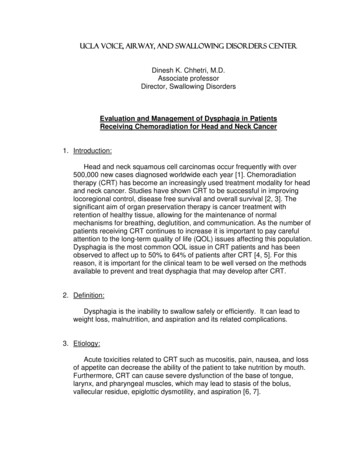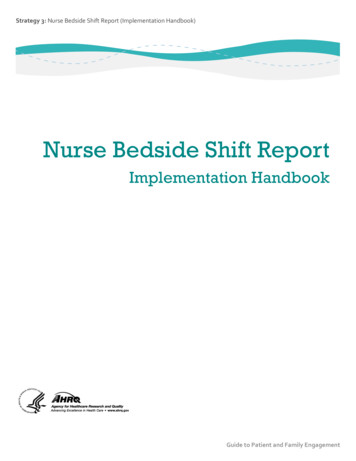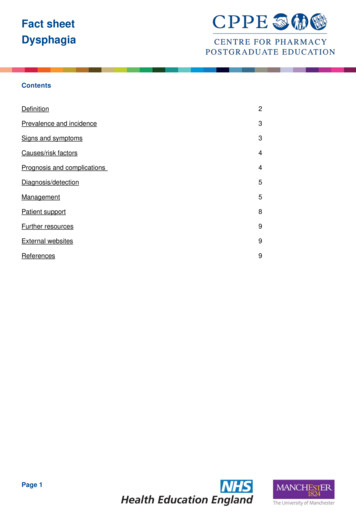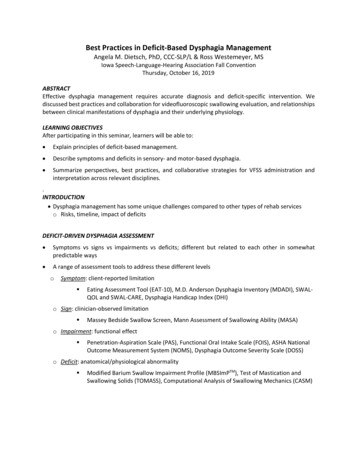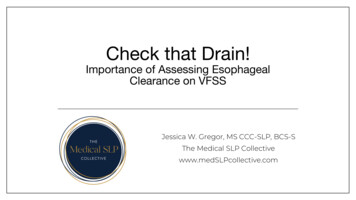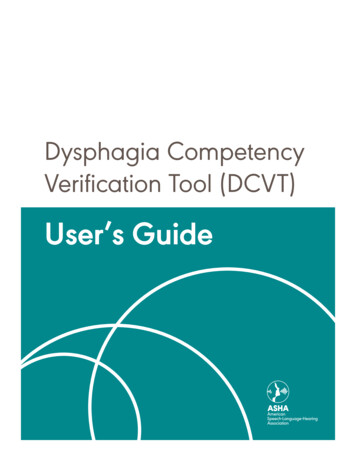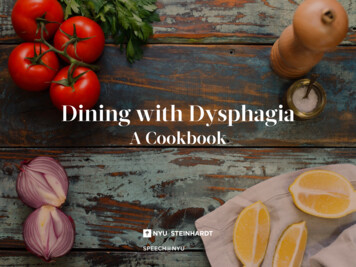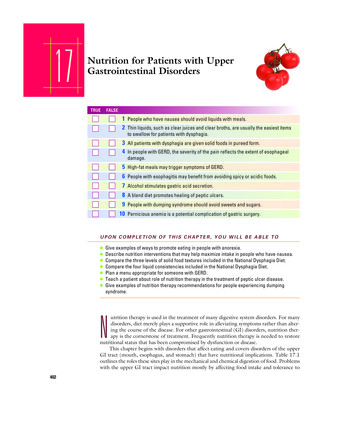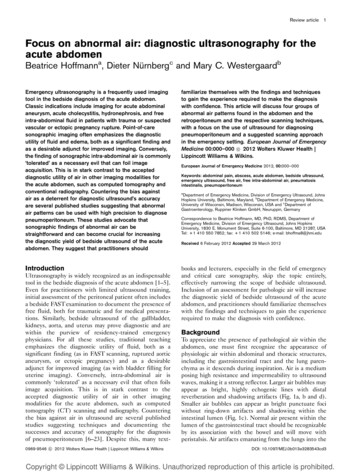
Transcription
Bedside Dysphagia EvaluationPatientDateFacility SLPOral-Motor EvaluationNote any abnormalities1. Structureedentulous CNAyes / nodenturesyes / no2. Awareness/Control of Secretionswears dentures when eatingdroolingyes / nodentures in during evalexcess secretions in mouthyes / nowet breath sounds3. Assessing Jaw, Lips and TongueJaw ControlCNALabial FunctionCNA /–lip spread /i/lip closure at restsymmetrydroopsentence (Please put the paper by the back door.)lip round /u/lip smackinglip closure on /p p p /Lingual FunctionCNAprotrusionlick lipslateralization to buccal cavityelevation of backrepetitive elevation of backfinal lingual shaping(Say something nice to Susan on Sunday.)retractionlateralization to cornerselevation of tiprepetitive elevation of tip /– /–R L /– /– /– /–v v vCNAprolonged /a/: symmetry during elevation /–Resonance:normalhypernasal /– /–R /– L /– /– /– /– /–R /– L /– /– /–4. Velar FunctionCNAgag reflex5. Reflexes/Responsesswallow response /–Laryngeal Examination /–hyponasalpalatal ref lex /– CNATracheostomy Tubecuffedfinger occludedVocal QualityVoluntary CoughThroat ClearingPitch RangeVolume ControlPhonation TimeValving for SpeechRespiratory Statusyes / noyes / noPM valveothernormal hoarsebreathy wetstrongweakabsentstrongweakabsent# of notesnoticeable change in loudness / –ability to control loudness / –# seconds prolonged /a/# syllables/breath group CNAPatient swallows during inhalation / ws One-Step DirectionsFollows Two-Step DirectionsExpressive LanguageIntelligibilityShort-Term MemoryCan patient retell techniques?Patient can hold breath for seconds. CNAday /– /–gestures/pointsunintelligibledatewith cueswith cuesuses single wordsdysarthriayearwithout cueswithout cuesuses phrasesapraxiaplaceconfused speechyes / noHearing Acuitywears hearing aid(s)hearing aid(s) in for evalyes / noyes / norightleftCommentsThe Source for Dysphagia: Third EditionCopyright 1996, 2000, 2007 LinguiSystems, Inc.
Bedside Dysphagia Evaluation, continuedPatient FacilitySLP Date Time ProcedureSwallowingKey –N/Askill is adequateskill is inadequatenot applicable for that textureSSPCCOstrawspooncupcut-out cupCompensatory TechniquesCD chin downHR head rotationBS bolus sizeEP external pressureTextureAbility to prepare boluslabial closure / –lingual elevation / –lingual lateralization / –mastication / –Ability to manipulate boluslingual function / –oral transit time / –Ability to maintain bolusback of tongue control / –labial closure / –cheeks / –lingual lateralization / –clears oral cavity in one swallow / –# swallows per bolusOropharyngeal Phaseinitiate reflex in seconds / –Laryngeal Characteristicsvocal quality / describecough/throat clearing / –elevation of larynx / –CommentsOral Phase Short-Term Goals/Treatment Objectives(Circle patient goals to be addressed.) These goals are for days/weeks.For related treatment objectives, see SLP Treatment Plan.1. (AL/jc) Improve jaw closure to reduce anterior loss to keep food/liquid in the mouth while eating.2. (AL/lc) Improve lip closure to reduce anterior loss to keep food/liquid in the mouth while eating.3. (AL/os) Improve oral sensation to reduce anterior loss to keep food in the mouth while eating.4. (BF/os) Increase oral sensation to improve the ability to put food/liquid into a cohesive bolus to reducethe risk of food residue falling into the airway.5. (BF/tm) Increase tongue movement to improve the ability to put food/liquid into a cohesive bolus toreduce the risk of food residue falling into the airway.6. (BF/tc) Increase tone in cheek(s) to improve the ability to put food/liquid into a cohesive bolus to reducethe risk of food residue falling into the airway.7. (BP/tm) Increase tongue movement to improve the ability to move a bolus to the back of the mouth in acoordinated fashion to reduce the risk of it falling into the airway.8. (BP/oc) Increase oral coordination to improve the ability to move a bolus to the back of the mouth in acoordinated fashion to reduce the risk of it falling into the airway.9. (BP/os) Increase oral sensation to improve the ability to move a bolus to the back of the mouth in acoordinated fashion to reduce the risk of it falling into the airway.10. (BP/ag) Increase awareness of food/liquid and utensils in the mouth to improve the ability to move a bolusto the back of the mouth in a coordinated fashion to reduce the risk of it falling into the airway.The Source for Dysphagia: Third EditionCopyright 1996, 2000, 2007 LinguiSystems, Inc.
Bedside Dysphagia Evaluation SampleFredPatient4-30-07DateCentral HospitalFacilitySLPOral-Motor EvaluationNote any abnormalities1. Structureedentulous CNAyes / nodenturesyes / no2. Awareness/Control of Secretionswears dentures when eatingdroolingyes / nodentures in during evalexcess secretions in mouthyes / no wet breath sounds3. Assessing Jaw, Lips and TongueJaw ControlCNALabial FunctionCNA /–lip spread /i/lip closure at restsymmetrydroopsentence (Please put the paper by the back door.)lip round /u/lip smacking CNAlip closure on /p p p / CNALingual FunctionCNAprotrusionlick lipslateralization to buccal cavityelevation of backrepetitive elevation of backfinal lingual shaping(Say something nice to Susan on Sunday.)retractionlateralization to cornerselevation of tiprepetitive elevation of tip /– /–R L /– /– /– /–v v vCNAprolonged /a/: symmetry during elevation /– normalResonance:hypernasal /– /–R /– L /– /– / – (A) / – (AC) /–R /– L /– / – (SP) / – (SP)4. Velar FunctionCNAgag reflex5. Reflexes/Responsesswallow response /–Laryngeal Examination /–hyponasalpalatal ref lex /– CNATracheostomy Tubecuffedfinger occludedVocal QualityVoluntary CoughThroat ClearingPitch RangeVolume ControlPhonation TimeValving for SpeechRespiratory Statusyes / noyes / noPM valveothernormal hoarsebreathy wetstrongweakabsentstrongweakabsent# of notes3noticeable change in loudness / –ability to control loudness / –# seconds prolonged /a/6# syllables/breath groupDNA CNAPatient swallows during inhalation / ws One-Step DirectionsFollows Two-Step DirectionsExpressive LanguageIntelligibilityShort-Term MemoryCan patient retell techniques?4 seconds.Patient can hold breath for CNA day /– /–gestures/pointsunintelligible datewith cueswith cuesuses single wordsdysarthria yearwithout cueswithout cuesuses phrasesapraxia placeconfused speechyes / nobut he’s alertHearing Acuityappears adequatewears hearing aid(s)hearing aid(s) in for evalyes / noyes / norightleftCommentsThe Source for Dysphagia: Third EditionCopyright 1996, 2000, 2007 LinguiSystems, Inc.
Bedside Dysphagia Evaluation Sample, continuedFredPatientFacilitySLP Date Time ProcedureSwallowing –N/AKeyskill is adequateskill is inadequatenot applicable for that textureSSPCCOCompensatory TechniquesCD chin downHR head rotationBS bolus sizeEP external pressurestrawspooncupcut-out cupsduidTexturegsreeliqyneegpuhoAbility to prepare bolus–––labial closure / –lingual elevation / –lingual lateralization / –N/A mastication / –N/Alingual function / –oral transit time / – –N/A – N/A –– Ability to manipulate bolusAbility to maintain bolusback of tongue control / –labial closure / –cheeks / –lingual lateralization / –clears oral cavity in one swallow / ––––CO EP ––EP ––EP ––EP – – – –222-32 / describewetwetwetwetcough/throat clearing / –elevation of larynx / – –– # swallows per bolusN/AOropharyngeal Phaseinitiate reflex in seconds / –Laryngeal Characteristicsvocal qualityCommentsOral Phase Short-Term Goals/Treatment Objectives(Circle patient goals to be addressed.) These goals are for2 days/weeks.For related treatment objectives, see SLP Treatment Plan.1. (AL/jc) Improve jaw closure to reduce anterior loss to keep food/liquid in the mouth while eating.2. (AL/lc) Improve lip closure to reduce anterior loss to keep food/liquid in the mouth while eating.Tx Obj 1, 2, 4, 63. (AL/os) Improve oral sensation to reduce anterior loss to keep food in the mouth while eating.4. (BF/os) Increase oral sensation to improve the ability to put food/liquid into a cohesive bolus to reducethe risk of food residue falling into the airway.5. (BF/tm) Increase tongue movement to improve the ability to put food/liquid into a cohesive bolus toreduce the risk of food residue falling into the airway.6. (BF/tc) Increase tone in cheek(s) to improve the ability to put food/liquid into a cohesive bolus to reducethe risk of food residue falling into the airway.Tx Obj 1, 2, 3, 6, 97. (BP/tm) Increase tongue movement to improve the ability to move a bolus to the back of the mouth in acoordinated fashion to reduce the risk of it falling into the airway.8. (BP/oc) Increase oral coordination to improve the ability to move a bolus to the back of the mouth in acoordinated fashion to reduce the risk of it falling into the airway.Tx Obj 2, 39. (BP/os) Increase oral sensation to improve the ability to move a bolus to the back of the mouth in acoordinated fashion to reduce the risk of it falling into the airway.10. (BP/ag) Increase awareness of food/liquid and utensils in the mouth to improve the ability to move a bolusto the back of the mouth in a coordinated fashion to reduce the risk of it falling into the airway.The Source for Dysphagia: Third EditionCopyright 1996, 2000, 2007 LinguiSystems, Inc.
Bedside Dysphagia Evaluation —Skilled Nursing Facilities Summary SheetDatePatient Birth Date AgePhysician Room #Medical DiagnosisMedical HistoryPertinent MedicationsCurrent Method of Nutrition: PO diet NPO NG/PEG/TPNPrecautionsHistory/Duration of Swallowing Problems/Recent ChangeSwallowing Function Prior to Onset/Recent ChangePrevious Evaluation/TreatmentEvaluation Findings/SummaryPositive Expectation to Begin ServiceNeed for Skilled ServiceDysphagia DiagnosisRecommendationsNPO — consider alternative feeding:NPO until instrumental examtrial therapeutic feeding only (no meal trays)tube feedings will be held a minimum of two hours before each mealPO:liquids: spoon / cup / strawmeds:supplemental tube feedingsSLP to treat meals/dayOT to treat meals/dayno therapeutic feeding by SLP indicatedno treatment at meals by OTinstrumental exam MBS FEES Speech/Language evalOT evalENT consult re:re-eval pending:positioning/feeding precautions as postedchin-downupright 90ºliquid washhead rotation R/Lmultiple swallowsref lux precautionsDietitian to interview patient/family to determine food preferencescalorie countreview chart for spiked tempsfeed with trach cuffup / down*Recommendations marked with * arePassy-Muir Valve on / offpending results of an instrumentalsuction per trach after each mealexam revealing if patient is safe to eat.other:The Source for Dysphagia: Third EditionCopyright 1996, 2000, 2007 LinguiSystems, Inc.
Bedside Dysphagia Evaluation — Skilled Nursing Facilities Summary Sheet, continuedRecommendations, continuedTreatment by SLP (See Treatment Plan.)functional maintenanceFrequency of serviceTreatment by OT (See Treatment Plan.)rehab diningDuration of serviceDischarge PlanLong-Term Goals(Circle goals to be addressed.) These goals are set for a one-month time period.1. Patient will safely consume diet with liquids withoutcomplications such as aspiration pneumonia.2. Patient will be able to eat foods and liquids with more normal consistency.3. Patient will be able to complete a meal in less than minutes.4. Patient will maintain nutrition/hydration via alternative methods.5. Patient’s quality of life will be enhanced through eating and drinking small amounts of food and liquid.6. Patient’s caregivers and family will demonstrate understanding of compensatory techniques to feed patient safely.Oral Phase Short-Term Goals/Treatment Objectives(Circle patient goals to be addressed.) These goals are for days/weeks. For related treatment objectives, see SLP Treatment Plan.1. (AL/jc) Improve jaw closure to reduce anterior loss to keep food/liquid in the mouth while eating.2. (AL/lc) Improve lip closure to reduce anterior loss to keep food/liquid in the mouth while eating.3. (AL/os) Improve oral sensation to reduce anterior loss to keep food in the mouth while eating.4. (BF/os) Increase oral sensation to improve the ability to put food/liquid into a cohesive bolus to reducethe risk of food residue falling into the airway.5. (BF/tm) Increase tongue movement to improve the ability to put food/liquid into a cohesive bolus toreduce the risk of food residue falling into the airway.6. (BF/tc) Increase tone in cheek(s) to improve the ability to put food/liquid into a cohesive bolus to reducethe risk of food residue falling into the airway.7. (BP/tm) Increase tongue movement to improve the ability to move a bolus to the back of the mouth in acoordinated fashion to reduce the risk of it falling into the airway.8. (BP/oc) Increase oral coordination to improve the ability to move a bolus to the back of the mouth in acoordinated fashion to reduce the risk of it falling into the airway.9. (BP/os) Increase oral sensation to improve the ability to move a bolus to the back of the mouth in acoordinated fashion to reduce the risk of it falling into the airway.10. (BP/ag) Increase awareness of food/liquid and utensils in the mouth to improve the ability to move a bolusto the back of the mouth in a coordinated fashion to reduce the risk of it falling into the airway.Speech-Language PathologistLicense #DateI certify that this patient requires therapy services, is under a plan of care established or reviewed every days by me, andrequires the specified treatment on a continuing basis with the following changes: .Physician Notice: (Circle one.)I do / do not find it necessary to see this patient within the next days.PhysicianThe Source for Dysphagia: Third EditionDateCopyright 1996, 2000, 2007 LinguiSystems, Inc.
Bedside Dysphagia Evaluation —Skilled Nursing Facilities Summary Sheet SampleDateEthel1-8-2384PatientBirth DateAgePhysician Room #Alzheimer’sMedical DiagnosisDiabetes, CHFMedical Historyreferred by Dr. Davis for oral dysphagia and weight lossAriceptPertinent Medications POregCurrent Method of Nutrition: diet NPO NG/PEG/TPNPrecautionslost 15 pounds over last 6 months on regular diet at homeHistory/Duration of Swallowing Problems/Recent Changeprior to last 6 months, she ate without difficultySwallowing Function Prior to Onset/Recent Changen/aPrevious Evaluation/TreatmentDifficulty forming bolus with masticated foods. Holds food in oral cavity up toEvaluation Findings/Summary15 seconds. With increased pressure and pureed foods, she swallows after 8 seconds. Coughs with thin liquids.Patient is cooperative with caregivers. Patient is alert and pleasant and likesPositive Expectation to Begin Servicetoeat.If patient’s diet and food presentation aren’t modified, she is at risk for aspiration andNeed for Skilled Servicecontinued weight loss.moderate oral dysphagia, suspected pharyngeal dysphagiaDysphagia DiagnosisRecommendations NPO — consider alternative feeding:NPO until instrumental examtrial therapeutic feeding only (no meal trays)tube feedings will be held a minimum of two hours before each mealpureedPO:honey thickliquids:spoon / cup / strawcrushed and mixedmeds:supplemental tube feedingsSLP to treat meals/dayOT to treat meals/dayno therapeutic feeding by SLP indicatedno treatment at meals by OT MBSinstrumental exam FEES Speech/Language evalOT evalENT consult re:re-eval pending:positioning/feeding precautions as posted chin-downupright 90ºliquid washhead rotation R/Lmultiple swallowsref lux precautionsDietitian to interview patient/family to determine food preferencescalorie countreview chart for spiked tempsfeed with trach cuffup / down*Recommendations marked with * arePassy-Muir Valve on / offpending results of an instrumentalsuction per trach after each mealexam revealing if patient is safe to eat.addedtactilestimtomouthother:The Source for Dysphagia: Third EditionCopyright 1996, 2000, 2007 LinguiSystems, Inc.
Bedside Dysphagia Evaluation — Skilled Nursing Facilities Summary Sheet Sample, continuedRecommendations, continued Treatment by SLP (See Treatment Plan.)functional maintenance90 mins/wkFrequency of service Treatment by OT (See Treatment Plan.)rehab dining2 weeksDuration of servicewhen MBS completed and staff trained on techniques to feed patient safelyDischarge PlanLong-Term Goals(Circle goals to be addressed.) These goals are set for a one-month time period.pureedhoney1. Patient will safely consumediet withliquids withoutcomplications such as aspiration pneumonia.2. Patient will be able to eat foods and liquids with more normal consistency.3. Patient will be able to complete a meal in less than minutes.4. Patient will maintain nutrition/hydration via alternative methods.5. Patient’s quality of life will be enhanced through eating and drinking small amounts of food and liquid.6. Patient’s caregivers and family will demonstrate understanding of compensatory techniques to feed patient safely.Oral Phase Short-Term Goals/Treatment Objectives(Circle patient goals to be addressed.) These goals are for days/weeks. For related treatment objectives, see SLP Treatment Plan.1. (AL/jc) Improve jaw closure to reduce anterior loss to keep food/liquid in the mouth while eating.2. (AL/lc) Improve lip closure to reduce anterior loss to keep food/liquid in the mouth while eating.3. (AL/os) Improve oral sensation to reduce anterior loss to keep food in the mouth while eating.4. (BF/os) Increase oral sensation to improve the ability to put food/liquid into a cohesive bolus to reducethe risk of food residue falling into the airway.Tx Obj 6, 8, 105. (BF/tm) Increase tongue movement to improve the ability to put food/liquid into a cohesive bolus toreduce the risk of food residue falling into the airway.6. (BF/tc) Increase tone in cheek(s) to improve the ability to put food/liquid into a cohesive bolus to reducethe risk of food residue falling into the airway.7. (BP/tm) Increase tongue movement to improve the ability to move a bolus to the back of the mouth in acoordinated fashion to reduce the risk of it falling into the airway.8. (BP/oc) Increase oral coordination to improve the ability to move a bolus to the back of the mouth in acoordinated fashion to reduce the risk of it falling into the airway.9. (BP/os) Increase oral sensation to improve the ability to move a bolus to the back of the mouth in acoordinated fashion to reduce the risk of it falling into the airway.10. (BP/ag) Increase awareness of food/liquid and utensils in the mouth to improve the ability to move a bolusto the back of the mouth in a coordinated fashion to reduce the risk of it falling into the airway.Speech-Language PathologistLicense #Tx Obj 1, 2, 3DateI certify that this patient requires therapy services, is under a plan of care established or reviewed every days by me, andrequires the specified treatment on a continuing basis with the following changes: .Physician Notice: (Circle one.)I do / do not find it necessary to see this patient within the next days.PhysicianThe Source for Dysphagia: Third EditionDateCopyright 1996, 2000, 2007 LinguiSystems, Inc.
Bedside Dysphagia Evaluation —Speech-Language Pathology Summary SheetDate PatientAdmit Date PhysicianAdmit DiagnosisMedical HistoryPertinent MedicationsCurrent Method of Nutrition: PO diet NPO NG/PEG/TPNHistory/Duration of Swallowing ProblemsRespiratory Status: O2 nasal/face mask/trach collar Intubated from to Trach placed onTrach type Ventilatory support: hours Eval done with patient on/off vent Cuff inflated/deflated Passy-Muir Valve on/offDysphagia DiagnosisLong-Term/Functional Goals (Circle goals to be addressed.)These goals are set for a time period.1. Patient will safely consume diet with liquids withoutcomplications such as aspiration pneumonia.2. Patient will be able to eat foods and liquids with more normal consistency.3. Patient will be able to complete a meal in less than minutes.4. Patient will maintain nutrition/hydration via alternative methods.5. Patient’s quality of life will be enhanced through eating and drinking small amounts of food and liquid.RecommendationsNPO — consider alternative feeding:NPO until instrumental examtrial therapeutic feeding only (no meal trays)tube feedings will be held a minimum of two hours before each mealPO:liquids: spoon / cup / strawmeds:supplemental tube feedingsSLP to treat meals/dayno therapeutic feeding by SLP indicatedinstrumental exam MBS FEES Speech/Language evalOT evalENT consult re:re-eval pending:positioning/feeding precautions as postedchin-downupright 90ºliquid washhead rotation R/Lmultiple swallowsref lux precautionsDietitian to interview patient/family to determine food preferencescalorie countreview chart for spiked tempsfeed with trach cuffup / down*Recommendations marked with * arePassy-Muir Valve on / offpending results of an instrumentalsuction per trach after each mealexam revealing if patient is safe to eat.other:Treatment by SLP (See Treatment Plan)Patient/Family Teaching GoalsWas patient/family teaching completed?(See Teaching Sheet for PO Feeding.) yes noSpeech-Language PathologistThe Source for Dysphagia: Third EditionCopyright 1996, 2000, 2007 LinguiSystems, Inc.
Bedside Dysphagia Evaluation —Speech-Language Pathology Summary Sheet SampleDatePatient4-30-07FredAdmit DatePhysician4-29-07Admit DiagnosisLCVAASCVD, HTN, IDDMMedical HistoryPertinent MedicationsN/A NPO NG/PEG/TPN given ice chipsCurrent Method of Nutrition: PO diet since admit with CVA; referred by M.D. for “choking”History/Duration of Swallowing Problems O2 nasal/face mask/trach collarRespiratory Status: Intubated from to Trach placed onTrach type Ventilatory support: hours Eval done with patient on/off vent Cuff inflated/deflated Passy-Muir Valve on/offoral dysphagia, suspected pharyngeal dysphagiaDysphagia DiagnosisLong-Term/Functional Goals (Circle goals to be addressed.)one monthThese goals are set for atime period.pureedhoney thick1. Patient will safely consumediet withliquids withoutcomplications such as aspiration pneumonia.2. Patient will be able to eat foods and liquids with more normal consistency.3. Patient will be able to complete a meal in less than minutes.4. Patient will maintain nutrition/hydration via alternative methods.5. Patient’s quality of life will be enhanced through eating and drinking small amounts of food and liquid.Recommendations * NPO — consider alternative feeding:NPO until instrumental examtrial therapeutic feeding only (no meal trays)tube feedings will be held a minimum of two hours before each mealpureedPO:honey thickliquids:spoon / cup / strawcrush and mixmeds:supplemental tube feedings2SLP to treatmeals/dayno therapeutic feeding by SLP indicatedinstrumental exam MBS FEES Speech/Language evalOT evalENT consult re:re-eval pending:positioning/feeding precautions as posted chin-downupright 90ºliquid wash head rotation R/Lmultiple swallowsref lux precautionsDietitian to interview patient/family to determine food preferencescalorie countreview chart for spiked tempsfeed with trach cuffup / down*Recommendations marked with * arePassy-Muir Valve on / offpending results of an instrumentalsuction per trach after each mealexam revealing if patient is safe to eat.other:Treatment by SLP (See Treatment Plan)Patient/Family Teaching Goals yesWas patient/family teaching completed? (See Teaching Fact Sheet for PO Feeding.) noSpeech-Language PathologistThe Source for Dysphagia: Third EditionCopyright 1996, 2000, 2007 LinguiSystems, Inc.
Case SamplesThe following nine case samples will help you refine your skills in making recommendations and determiningshort- and long-term goals and treatment objectives based on findings from instrumental studies. The casesare presented in summary form. Long-term goals and short-term goals are established for each patient.Cursory information from the instrumental study is in the first column. The symptom is listed and thephysiological cause of that symptom is indicated in italics. At the end of the findings, information aboutthe effects of treatment strategies tried during the instrumental study are listed. The middle column containsrecommendations based on the findings from the instrumental study. If treatment for that finding is indicated,the corresponding short-term goals tried during the instrumental study are listed. The third column suggestspossible treatment objectives for the problem(s) identified in the findings. The treatment objectives are basedon the physiological cause of each symptom and the codes indicate the short-term goal to which that objectiveis related.For example, a significant finding for Case 1 shows that the patient could form a bolus with any foodpresented. The recommendation is that he can have any and all textures he feels he can handle. No specifictreatment will be needed, so no short-term goal is listed. However, another finding showed that thin liquidstrickled over the back of the tongue prematurely. The recommendation is for the patient to use chin-on-chestposition for thin liquids. Because this requires treatment, a short-term goal is listed. Treatment objectiveswere selected from those designed to address aspiration before the swallow due to reduced tongue control(AB/tc).A treatment objective can address more than one short-term goal. When you list an objective on yourtreatment plan, you can use the code that applies to the main reason you chose that objective or you can listboth codes. For example, in Case 6, the patient has significant vallecular and pyriform sinus residue. Thecompensatory treatment objective that “Patient will remain seated upright at 90 without cues for 30 minutesafter any PO intake” was chosen to reduce risk of food falling from valleculae and pyriforms into the airway.Therefore, it could be coded as AA/v/tb-3 (related to the short-term goal to reduce risk of aspiration after theswallow from the valleculae due to decreased tongue base strength) and AA/p/le-5 (related to the short-termgoal to reduce risk of aspiration after the swallow from the pyriforms due to reduced laryngeal elevation).It could even be coded AA/V/ppw-3 (related to the short-term goal to reduce the risk of aspiration after theswallow from the valleculae due to reduced movement of the pharyngeal walls) if you felt that was the mainreason for the vallecular residue.Cases 8 and 9 involve patients considered inappropriate for therapy. These case samples show how therecommendations are based on selected findings.The Source for Dysphagia: Third EditionCopyright 1996, 2000, 2007 LinguiSystems, Inc.
Case 1HistoryAcute cerebrovascular accident, primary brainstem hemorrhage secondaryto hypertensionLong-Term Goal 1Patient will safely consume regular diet with liquids without complicationssuch as aspiration pneumonia.Short-Term Goal 11 (AB/tc)Patient will improve back of tongue control to keep food from falling overthe back of the tongue and into the airway.Short-Term Goal 15 (AA/p/le)Patient will increase laryngeal elevation to reduce residue in the pyriformsinus(es) and reduce risk of the residue falling into the airway after theswallow.Short-Term Goal 16 (AA/p/hcm)Patient will increase anterior movement of the hyolaryngeal complex toreduce residue in the pyriform sinuses and reduce the risk of the residuefalling into the airway after the swallow.Short-Term Goal 18 (AA/lv/at)Patient will improve arytenoid tipping/closure at entrance to airway toreduce penetration into the upper laryngeal vestibule to reduce the riskof the penetrated material being aspirated after the swallow.Short-Term Goal 20 (AA/v/tb)Patient will increase base of tongue movement to reduce vallecular residue(unilateral or bilateral) to reduce the risk of the residue being aspirated afterthe swallow.Short-Term Goal 21 (AA/v/ppw)Patient will increase movement of the posterior pharyngeal wall to reducevallecular residue to reduce the risk of the residue being aspirated afterthe swallow.Selected Finding:Symptoms and Physiology(physiology shown in italics below)Oral PhasePatient is somewhat slow tomasticate the cookie, but isable to form a good bolus.Oropharyngeal PhaseIf the patient isn’t in a chin-downposition, thin liquids trickle over theback of the tongue prematurely dueto decreased strength and controlof back of tongue.The Source for Dysphagia: Third EditionRecommendations andShort-Term GoalsBased on FindingsTreatmentObjectivesAny and all textures patient feelsable to handleChin-on-chest position for allswallows (Short-Term Goal 11 –AB/tc-1) (Note: Sometimes it iseasier for a patient to rememberto use chin-down on all swallowsthan for only selected textures.This patient is aspirating only thinliquids, but later shows penetrationof paste that could be eliminatedwith chin-down position
X Oral-Motor Evaluation CNA 1. StructureNote any abnormalities _ edentulous yes / no dentures yes / no wears dentures when eating yes / no dentures in during eval yes / no 2. Awareness/Control of Secretions _ drooling _
